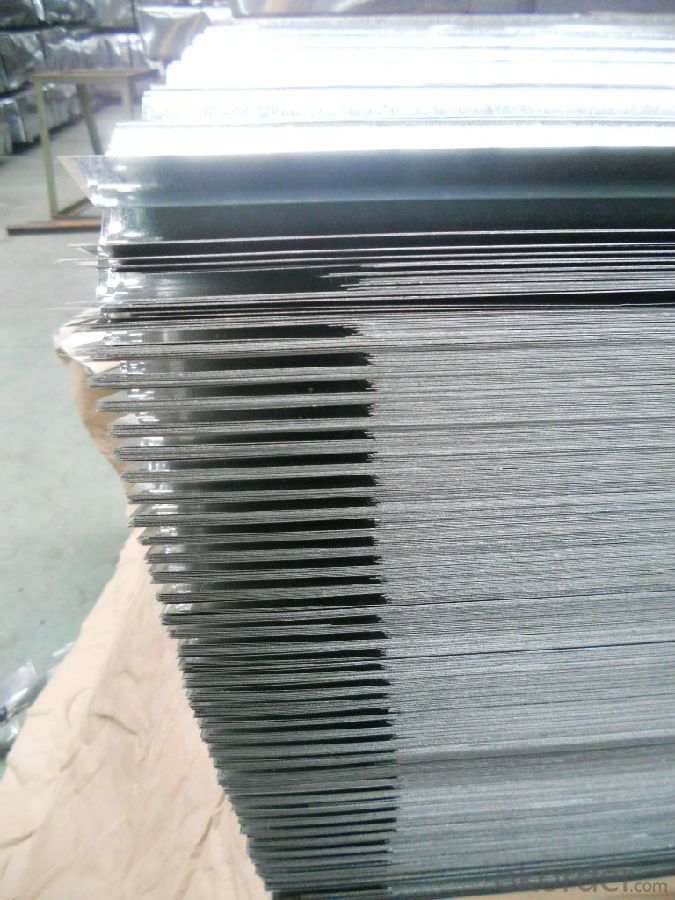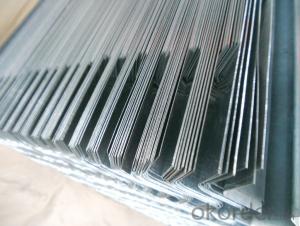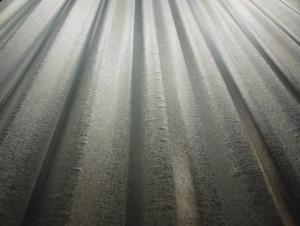Corrugated-Hot Dipped Galvanized Steel-Sheet
- Loading Port:
- Tianjin
- Payment Terms:
- TT OR LC
- Min Order Qty:
- 50 m.t.
- Supply Capability:
- 2000 m.t./month
OKorder Service Pledge
OKorder Financial Service
You Might Also Like
Description:
Corrugated steel sheet is the galvanized steel plate which has been wave formed with the cold rolling treatment, trough especial coated dispose
Pressing steel panel with the clear line, and many colors for choice, suitable for any different building style materials, achieving satisfy effects;
Pressing steel panel can be freely incised, it can satisfy the especially designing demands. It apply on convenient construction, and anti-seismic performance, fire proof, waterproof, free of maintenance
Base sheet : galvanized steel sheet, pre painted galvanized steel sheet


Application:
With excellent cold bending molded manufacturablity, good decoration effect, strong anti-corrosion ability, are also pollution-free and easily recycled. Accordingly, they can be used as final products and basic plates of color coated steel coils and widely applied in construction, home appliances, decoration
Product Specification:
Thickness tolerance: (+/-0.01mm)
Zinc coating: 50-180g/m2
Standard:JIS G 3302, SGCH
Package: 2- 3 ton/pallet
Specs: 0.14-0.8mm x 900mm x 2000mm
Width:700-1250mm
Surface:regular/mini/zero spangle, chromated, skin pass, dry etc.
Package:Standard seaworthy export packing: 3 layers of packing, inside is kraft paper,water plastic film is in the middle and outside GI steel ,sheet to be covered by steel strips with lock.
FAQ:
1.How many pieces for one package?
The pieces for one tone is decided by the thickness of the sheet, but we can make it according to your requirements in the reasonable range.
2. Could you produce the sheets according to our design?
Yes, we can.
3. Do you have pallets for the package?
Yes, we must use pallets for the package in order to load.
- Q: Can steel sheets be used for manufacturing shipping pallets?
- Yes, steel sheets can be used for manufacturing shipping pallets. Steel is a strong and durable material that can withstand heavy loads, making it suitable for the construction of pallets. Steel sheets can be welded or bolted together to create a sturdy and reliable pallet structure. Additionally, steel pallets have the advantage of being resistant to moisture, pests, and fire, which can be important considerations for certain industries or applications. However, it is worth noting that steel pallets are generally more expensive than other materials such as wood or plastic, so the choice of using steel sheets for manufacturing shipping pallets would depend on specific requirements, budget, and intended use.
- Q: What are the insulation properties of steel sheets?
- Steel sheets have relatively poor insulation properties compared to other materials commonly used for insulation, such as fiberglass or foam. This is because steel is a good conductor of heat and electricity. It has high thermal conductivity, meaning that it can easily transfer heat from one side to the other. Therefore, steel sheets are not effective in preventing heat transfer and are not typically used as insulation materials on their own. However, steel sheets can still provide some insulation benefits when used in combination with other insulating materials. For instance, steel sheets can be used as a protective layer or cladding to enhance the durability and fire resistance of insulation systems. They can also be used as a radiant barrier, reflecting heat away from the building and reducing heat gain in warm climates. In summary, while steel sheets themselves do not have great insulation properties, they can play a role in enhancing the overall insulation performance when combined with other insulating materials or used in specific applications like radiant barriers.
- Q: Are steel sheets suitable for railway infrastructure?
- Yes, steel sheets are suitable for railway infrastructure. Steel is a widely used material in the construction of railway infrastructure due to its strength, durability, and versatility. One of the main advantages of using steel sheets for railway infrastructure is their high strength-to-weight ratio. Steel is known for its exceptional strength, allowing it to withstand heavy loads and provide long-lasting support to railway tracks, bridges, and other structures. This strength is crucial in ensuring the safety and stability of the railway system, especially when dealing with the immense weight and impact forces exerted by trains. Additionally, steel sheets offer excellent durability and resistance to wear and tear. Railway infrastructure is subjected to constant stress, including vibrations, impacts, and extreme weather conditions. Steel's inherent properties make it highly resilient to these factors, minimizing the need for frequent repairs and maintenance. This durability translates into significant cost savings in the long run, as steel structures have a longer lifespan compared to other materials. Moreover, steel sheets are highly versatile and can be easily fabricated into various shapes and sizes to meet specific railway infrastructure requirements. This flexibility allows for the efficient construction of rails, sleepers, bridges, and other components needed for a functional and safe railway system. Steel's adaptability also enables easy modifications and expansions to the infrastructure as needed, ensuring compatibility with evolving transportation needs. In conclusion, steel sheets are well-suited for railway infrastructure due to their strength, durability, and versatility. Their high strength-to-weight ratio, resistance to wear and tear, and ease of fabrication make them an ideal choice for constructing and maintaining railway tracks, bridges, and other structures. The use of steel in railway infrastructure ensures the safety, efficiency, and longevity of the railway system.
- Q: How are steel sheets protected during storage in outdoor environments?
- Steel sheets are protected during storage in outdoor environments through the application of various protective measures. These measures may include the use of weather-resistant coatings, such as galvanization or paint, to prevent corrosion and rusting. Additionally, steel sheets can be stored on pallets or racks to minimize contact with the ground and reduce the risk of moisture accumulation. Covering the sheets with tarpaulins or using weatherproof storage containers further shields them from direct exposure to rain, snow, and sunlight. Regular inspections and maintenance are crucial to ensure the effectiveness of these protective measures and to address any potential issues promptly.
- Q: Can steel sheets be used for transportation applications?
- Yes, steel sheets can be used for transportation applications. Steel is a popular material in the automotive and aerospace industries due to its high strength, durability, and resistance to corrosion. Steel sheets are commonly used for various transportation components such as chassis, body panels, doors, and structural parts. They provide excellent structural integrity and can withstand heavy loads, making them suitable for vehicles and aircraft. Additionally, steel sheets can be easily formed, welded, and machined, allowing for customization and efficient manufacturing processes.
- Q: What are the different sheet metal bending techniques for steel sheets?
- There are several sheet metal bending techniques commonly used for steel sheets. These techniques allow for the manipulation and shaping of steel sheets to achieve desired forms and angles. Some of the most common techniques include: 1. V-bending: This technique involves using a V-shaped punch and die set to create a sharp bend in the steel sheet. The material is placed between the punch and die, and force is applied to form the desired angle. V-bending is a versatile technique that can create various angles and shapes. 2. Air bending: In this technique, a punch is used to press the steel sheet into a V-shaped die, but without completely contacting the material. The bending is achieved by controlling the depth of penetration of the punch into the material. Air bending allows for greater flexibility in terms of angle adjustments and requires less force than other techniques. 3. Edge bending: As the name suggests, this technique involves bending the edge of the steel sheet. It is commonly used to create flanges or edges with specific angles. Edge bending is achieved by clamping the sheet between a punch and a die, and applying force to bend the material along the edge. 4. Bottom bending: This technique is used to create larger bends in steel sheets. It involves clamping the sheet between a punch and a V-shaped die, and then applying force to bend the material around the die. Bottom bending is suitable for creating U-shaped parts or boxes. 5. Roll bending: Also known as cylindrical bending, this technique is used to create cylindrical or curved shapes in steel sheets. The sheet is passed through a set of rolls, which gradually bend the material into the desired shape. Roll bending is commonly used in the production of pipes, tubes, and cylinders. 6. Coining: Coining is a precision bending technique that creates crisp, sharp bends. It involves pressing the steel sheet between a punch and a die, with the die featuring a sharp edge. The material is subjected to high pressure, resulting in a precise and defined bend. These are just a few of the many sheet metal bending techniques available for steel sheets. Each technique has its advantages and applications, and the choice of technique depends on factors such as the desired angle, the thickness of the sheet, and the complexity of the shape being formed.
- Q: Are the steel sheets resistant to vibration or shock?
- Yes, steel sheets are generally resistant to vibration and shock. Steel is known for its high strength and durability, making it capable of withstanding external forces such as vibrations and shocks. The rigid nature of steel allows it to absorb and distribute the energy caused by vibrations or shocks, preventing any significant damage or deformation. Additionally, steel sheets are often used in applications where resistance to vibrations and shocks is crucial, such as in construction, automotive, and aerospace industries. However, it is important to note that the exact resistance of steel sheets to vibration or shock will depend on factors such as the thickness and quality of the steel used, as well as the specific magnitude and frequency of the vibrations or shocks.
- Q: Are the steel sheets available in different colors?
- Indeed, a variety of colors are accessible when it comes to steel sheets. To cater to specific aesthetic or design inclinations, steel sheets can undergo coating or painting processes in diverse shades. The available color selections may differ depending on the manufacturer or supplier, although popular options encompass black, white, gray, blue, red, and green. Furthermore, certain steel sheets may possess a textured or patterned finish that amplifies their visual allure.
- Q: Can steel sheets be used for mezzanine flooring?
- Indeed, mezzanine flooring can make use of steel sheets. Mezzanine flooring benefits from the numerous advantages provided by steel sheets, such as their strength, durability, and versatility. Steel sheets are capable of withstanding substantial loads and offer a dependable and stable solution for flooring needs. Moreover, they can be easily tailored to suit specific dimensions and requirements, making them adaptable for various mezzanine designs. Additionally, steel sheets exhibit resistance to fire, moisture, and pests, guaranteeing a flooring option that is long-lasting and requires minimal maintenance. In summary, due to their robustness, durability, and adaptability, steel sheets are a popular choice for mezzanine flooring.
- Q: Can steel sheets be used for reinforcing concrete structures?
- Yes, steel sheets can be used for reinforcing concrete structures. They are commonly used as reinforcement in concrete construction due to their high strength, durability, and ability to withstand high loads and provide structural support. Steel sheets are often used to reinforce concrete walls, slabs, beams, and columns, enhancing the overall strength and stability of the structure.
Send your message to us
Corrugated-Hot Dipped Galvanized Steel-Sheet
- Loading Port:
- Tianjin
- Payment Terms:
- TT OR LC
- Min Order Qty:
- 50 m.t.
- Supply Capability:
- 2000 m.t./month
OKorder Service Pledge
OKorder Financial Service
Similar products
Hot products
Hot Searches
Related keywords




























